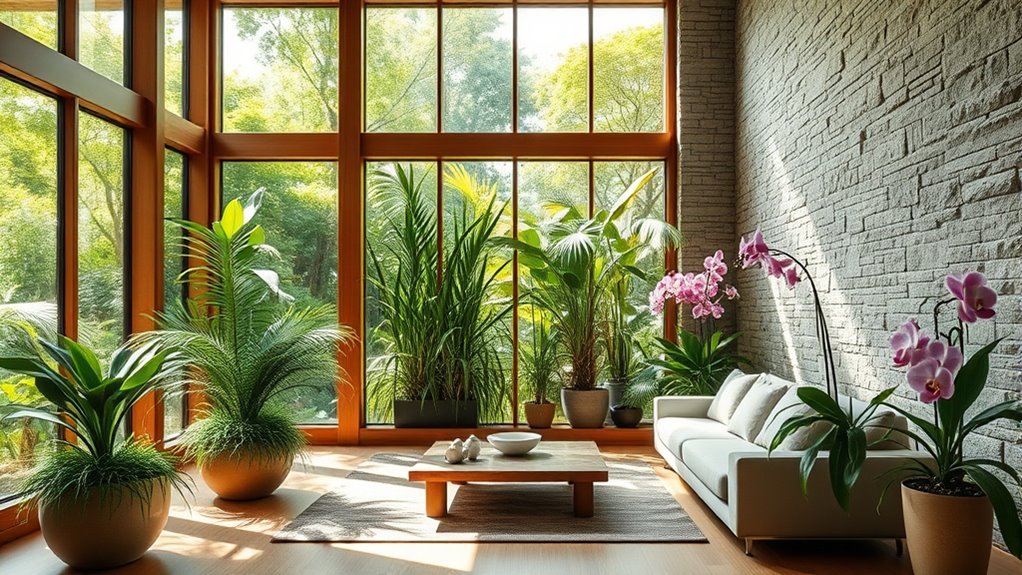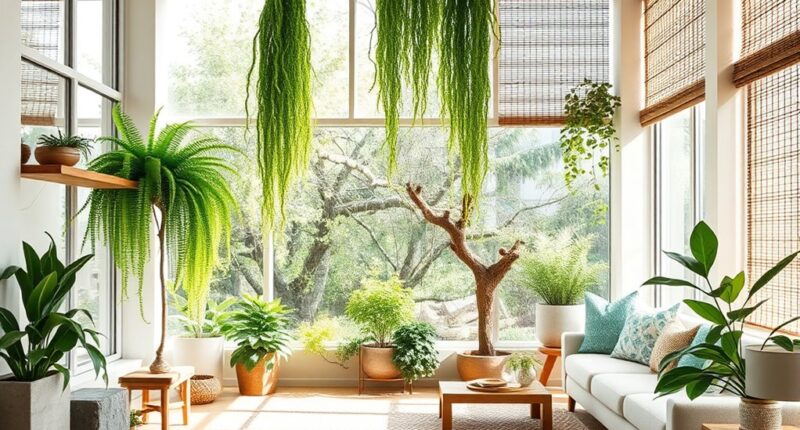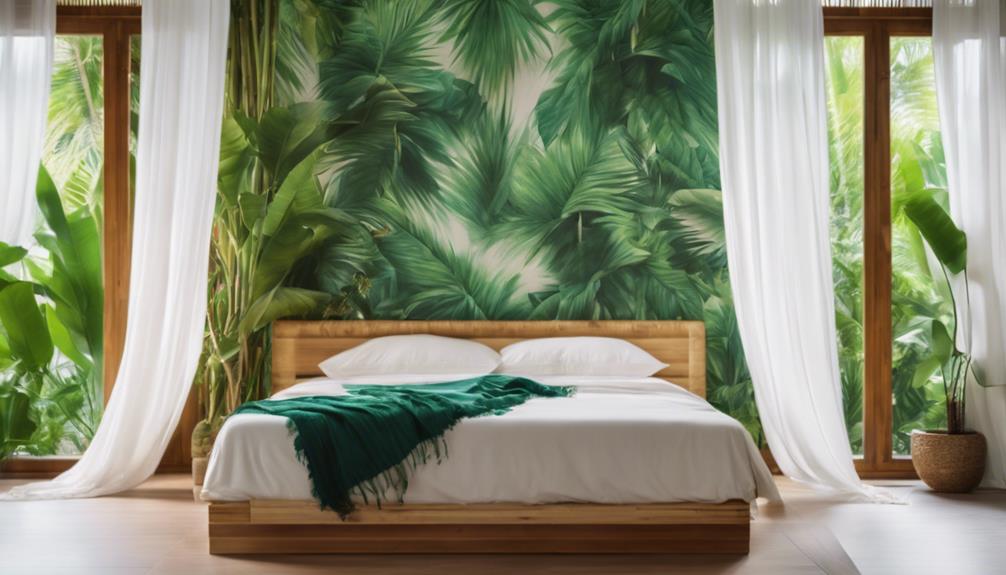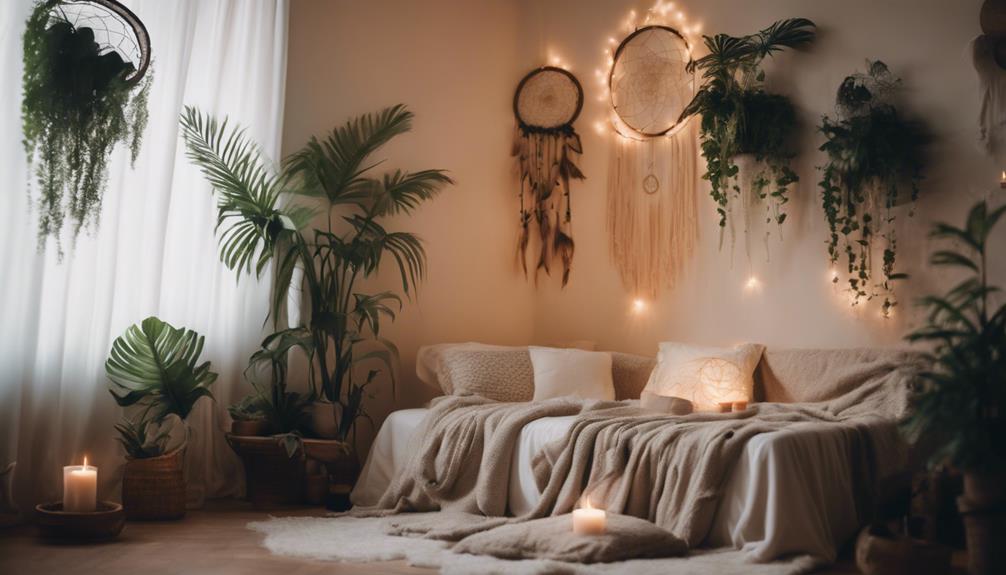Biophilic design helps you bring nature indoors by incorporating elements like plants, natural light, and organic materials into your space. These features boost your well-being by improving air quality, reducing stress, and creating a calming environment. Placing indoor plants near windows and letting in ample sunlight can make your space more lively and inviting. To discover more about creating a healthier, more vibrant environment, keep exploring ways to integrate nature into daily life.
Key Takeaways
- Integrates natural elements like plants and sunlight to create calming indoor environments aligned with biophilic principles.
- Enhances mental and physical well-being by connecting occupants with nature within built spaces.
- Utilizes natural light and indoor plants to improve air quality, mood, and productivity.
- Supports sustainable design through the strategic placement of natural features for maximum health benefits.
- Employs practical tips like positioning plants near windows and using reflective surfaces to optimize natural light indoors.

Have you ever wondered how incorporating natural elements into built environments can boost your well-being? The answer lies in biophilic design, which emphasizes connecting humans with nature inside the spaces where they spend most of their time. When you bring elements like indoor plants and natural light into your environment, you create a more inviting, calming space that supports your mental and physical health. Indoor plants are more than just decorative accents; they improve air quality by filtering toxins and releasing oxygen, making your space healthier. Whether you opt for lush ferns, sleek succulents, or vibrant flowering plants, their presence offers visual relief and a soothing touch that can reduce stress and anxiety. The act of caring for plants also fosters a sense of responsibility and mindfulness, contributing to overall emotional well-being.
Natural light plays an equally essential role in biophilic design. Sunlight not only illuminates your space but also influences your circadian rhythms, helping regulate sleep cycles and boost your energy levels during the day. When you maximize natural light through well-placed windows, skylights, or glass doors, you enhance the overall ambiance of your environment, making it feel more open and lively. This exposure to daylight can elevate your mood and increase productivity, especially in work or study areas. Combining indoor plants with ample natural light creates a cycle of benefits—plants thrive in sunlight, and you benefit from the vibrant, lively atmosphere they generate. Incorporating natural elements into your environment is a fundamental aspect of biophilic design, which aims to reconnect us with nature despite urban living.
Implementing these elements is straightforward and impactful. Position your indoor plants near windows where they can soak up natural light, and consider using sheer curtains to diffuse harsh sunlight while maintaining brightness. Make sure your plants receive the right amount of light specific to their needs, and rotate them regularly to ensure even growth. During darker months or in spaces with limited sunlight, supplement with grow lights to keep your plants healthy. As for natural light, think about rearranging furniture to optimize sunlight flow or adding reflective surfaces that amplify daylight. When you thoughtfully combine indoor plants with natural light, you create a space that feels alive, balanced, and restorative. You’ll notice how these simple yet powerful elements can transform your environment into a sanctuary that nurtures your well-being, making every day a little brighter and more connected to nature.
Frequently Asked Questions
How Does Biophilic Design Impact Indoor Air Quality?
You notice that biophilic design improves indoor air quality by encouraging air filtration and humidity regulation. By incorporating natural elements like plants, you enhance air circulation and filter out pollutants, making the space healthier. Plants also help regulate humidity levels, reducing mold and allergens. As a result, you experience fresher air, improved comfort, and a more inviting environment that promotes wellbeing and productivity.
Can Biophilic Elements Reduce Stress in Urban Environments?
You’ll find that incorporating biophilic elements, like urban green spaces and natural lighting, markedly reduces stress. Studies show people in greener environments experience 20% lower cortisol levels, indicating less stress. By connecting indoor spaces with outdoor nature through plants and large windows, you create a calming atmosphere. This approach helps you feel more relaxed, improves mood, and enhances overall wellbeing, making urban environments feel less overwhelming and more restorative.
What Are Cost-Effective Ways to Incorporate Nature Into Small Spaces?
You can incorporate nature into small spaces by trying DIY greenery projects, like creating wall planters or hanging gardens with inexpensive materials. Budget gardening is also effective—use affordable pots and easy-to-grow plants like succulents or herbs. These options are cost-effective and simple to maintain, helping you bring natural elements indoors without breaking the bank. Start small, and you’ll quickly enjoy the calming benefits of nature right in your space.
How Does Biophilic Design Influence Productivity at Work?
Think of your workspace as a garden where productivity blooms. Biophilic design boosts your focus and creativity by maximizing natural light and incorporating ergonomic furniture, which keeps you comfortable and alert. When you feel connected to nature, your stress decreases, making it easier to concentrate. By bringing these elements into your work environment, you create a vibrant space that nurtures your performance and well-being, much like sunlight nurtures plants.
Are There Specific Plants Recommended for Indoor Biophilic Environments?
You should choose indoor plant selection that includes low maintenance greenery like snake plants, pothos, and ZZ plants. These plants thrive with minimal care, making them perfect for busy environments. They improve air quality and add natural beauty, enhancing your workspace’s calming atmosphere. By incorporating these easy-care options, you create a healthier, more inviting space that boosts your mood and productivity without the hassle of high-maintenance plants.
Conclusion
By embracing biophilic design, you invite nature’s gentle embrace into your daily life, turning your space into a vibrant oasis of calm and energy. It’s like planting a seed of serenity that blossoms into well-being, transforming your environment into a sanctuary where your spirit can breathe and flourish. So, open the door to nature’s healing touch—your well-being will thank you as you grow happier, healthier, and more connected with the world outside.









